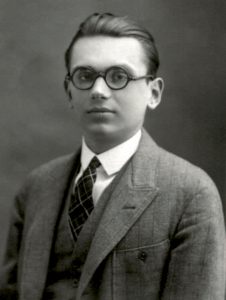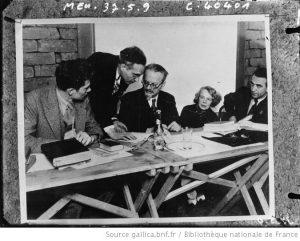The IMUS, with the participation of the Faculty of Mathematics, will celebrate the main day of the Year of Gödel on Wednesday 2 March, with various conferences on his personality and scientific work.
The great mathematician Gian-Carlo Rota (1932-1999), who was for some years at Princeton with the logicians Alonzo Church (1903-1995) and Kurt Gödel (1906-1978), wrote: “It cannot be mere coincidence that several of the most outstanding logicians of the 20th century were committed to mental institutions at some point in their lives: Cantor, Zermelo, Gödel, Peano and Post are a few examples. Alonzo Church was one of the sanest of the outstanding logicians, although in some ways his behaviour must be described as bizarre, even compared to the standard behaviour of a mathematician”.

Of all of them, Gödel perhaps takes the cake as a unique personality. Gödel went into exile in the United States at the outbreak of the Second World War, where he found a research position at Princeton. He was a loner, a social misfit who spent most of his life thinking, and searching for the boundaries of what is logically admissible. Of the few friends Gödel had, one was Einstein, with whom he used to walk almost daily in Princeton, from 1942 until the physicist’s death in 1955. It was surprising to many that two such different personalities could be so well matched; according to Ernst Straus, who served for a time as Einstein’s assistant at Princeton, Einstein was “sociable, happy, a sea of laughter and common sense”, while Gödel was “extremely solemn, very serious, rather solitary, and distrustful of common sense as a tool for reaching the truth”. It is significant that when Einstein turned 70, Gödel gave him a peculiar solution of the equations of general relativity in which time was cyclical and events were condemned to eternal return. In this Gödelian cosmos, travel backwards in time is possible: “If in these universes,” wrote Gödel himself, “we take a round trip in a rocket on a sufficiently wide curve, it is possible to travel to any region of the past, present and future, and back, just as in other universes it is possible to travel to distant regions of space”.

According to his death certificate, Gödel died of malnutrition and starvation as a result of a personality disorder: wary of being poisoned, he decided to stop eating.
Alan Turing (1912-1954), on the other hand, was driven to suicide by the moral mores of 1950s England; despite his worth as a scientist, despite the important role he had played during the Second World War in deciphering the Enigma code used by the Nazis for their secret military communications, he was convicted by the British judiciary in 1952 for homosexual practices. He was offered two options, either prison or chemical castration. He chose the latter, but the situation provoked was more than his dignity could bear, and he committed suicide in June 1954.

“Some might think that something as abstract as logic could only attract cold and bloodless personalities,” wrote Jesús Mosterín in the introduction to his book Los lógicos (The Logicians). “But appearances are deceptive. Under the ice of pure reason sometimes burns a burning flame and a tormented heart”. Mosterín followed with an outline of Jean van Heijenoort’s life: in his early twenties he was an assistant to Trotsky (1912-1986), whom he followed during his exiles in Turkey, France, Norway and Mexico (there van Heijenoort was Frida Kahlo’s lover). Van Heijenoort left Trotsky shortly before the Spaniard Ramón Mercader stuck an ice axe into his head; he settled in the United States where he studied logic and the philosophy of science and became a renowned historian of logic (he partly edited the complete works of Gödel). “Far from any coldness, he spent his life in stormy amorous passions with his various wives and mistresses” –I keep quoting Mosterín–. “His last wife, the Mexican Ana María, described him as “a flame of pure fire” as soon as she met him. They both burned in that fire. Once they were separated, and Jean was at Stanford editing Gödel’s complete works, Ana María ordered him to return to Mexico immediately, because she wanted to commit suicide and kill him. He cancelled all his engagements and took the first plane to Mexico. There, in bed, she shot him three times in the skull and then shot herself in the mouth, as she had announced”.
In view of all these examples, it is undeniable that a certain melodramatic temptation may incline us to establish a relationship between the study of logic and madness, even though the present writer is convinced that such a relationship is certainly non-existent.
References
Antonio J. Durán, Crónicas matemáticas, Crítica, Barcelona, 2018.
Jesús Mosterín, Los lógicos, Espasa, Madrid, 2000.

Leave a Reply